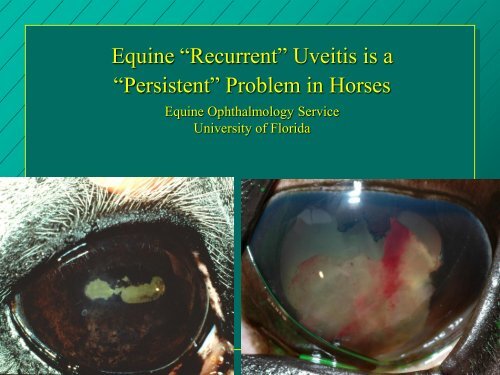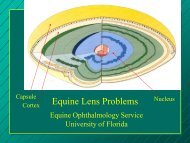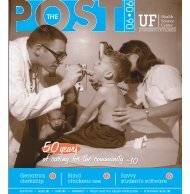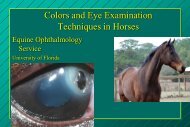Equine ERU - University of Florida
Equine ERU - University of Florida
Equine ERU - University of Florida
Create successful ePaper yourself
Turn your PDF publications into a flip-book with our unique Google optimized e-Paper software.
<strong>Equine</strong> “Recurrent” Uveitis is a“Persistent” Problem in Horses<strong>Equine</strong> Ophthalmology Service<strong>University</strong> <strong>of</strong> <strong>Florida</strong>
Uveitis starts as blood-ocularbarrier compromise!• Blood vessels <strong>of</strong> iris,CB and choroidbecome thickened,congested and “leaky”• Cells and mediatorsenter the eye– PMNs then LCs– Inflammatorycytokines
Lymphocyte infiltration• Heavy influx <strong>of</strong> LCinto uveal and othereye tissues• Clusters <strong>of</strong> LCresembling follicles inciliary body• T-LCs predominate,MHC Class II reactive
Theories on the “Lepto Link”• Is equine uveitis due to DIRECTTOXICITY <strong>of</strong> intraocular infection?– This may be the case in Europe.– <strong>ERU</strong> is actually “ocular leptospirosis” not <strong>ERU</strong>• Is it as AUTOIMMUNE DISORDERtriggered by molecular mimicry?• Are leptospira somehow MODULATINGTHE IMMUNE RESPONSE in the eye?
Testing for Leptospirosis• Most significant are L. pomona and L.grippotyphosa• L. pomona most important in USA-Titers > 1:400 are significant-Rarely will rising titer be found in pairedsamples--sampling too late in course <strong>of</strong> disease.• Uveitis from lepto occurs later than the systemicinfection.• Some horses with lepto in eyes are seronegative!
• Persistent Leptospirosis may sustain the autoimmuneattacks and be a subset <strong>of</strong> <strong>ERU</strong>.– <strong>ERU</strong> Eyes: L. gryppotyphosa cultured from vitreous <strong>of</strong>52% uveitis eyes in Germany and pomona fromaqueous humor <strong>of</strong> 20% (70% DNA+) uveitis eyes inUSA• Locally produced antibodies against Lepto crossreact with the cornea, lens and retina (S-antigenand IRBP).• Not all horses positive for L. pomona have uveitis.– The serologic evidence <strong>of</strong> pomona infection is morefrequent than the incidence <strong>of</strong> <strong>ERU</strong>.
Breed and UveitisColor pattern more at riskColor pattern less at risk• In Western NY,Appaloosas are 8.3 timesmore likely to suffer fromuveitis than other breeds• At risk individuals tend tohave coat patterns withoverall roan or light coats,little pigment aroundeyelids, sparse manes andtails• Germany: Warmbloods atrisk, ELA geneticstheorized.
• Percentage <strong>of</strong> horses with uveitis losingsight in at least one eye if Lepto + (11 yrs):+ Appaloosa 100%- Appaloosa 71%+ nonAppaloosa 52%- nonAppaloosa 34%
The more pigment, the less <strong>ERU</strong>, and the less CSNB!
Iris color changed to brown
150952
Keratic Precipitates (KPs)
PMNs give a green appearance in <strong>ERU</strong>.
210202
<strong>ERU</strong> and fibrin (Cookie)
Gypsy and Tissue Plasminogen Activator
Fibrin is removed by TPA
156113
Tissue Plasminogen Activator• Cathflo Activase® (Alteplase®) Genentech:– 100 µgm/0.1ml– $121/14 doses
Corpora nigra atrophy in <strong>ERU</strong>
Endotheliitis: precursor <strong>of</strong> glaucoma??
Vertical edema??Ventral edema from <strong>ERU</strong> is most typical
Tear film is unstable with edema
MiosisCorneal scarring
Fibrin plaque in pupil.<strong>ERU</strong> causes cataracts. Some feeloral aspirin reduces this.Why is the pupil dilated?
synechia
Moon
• Found at all stages <strong>of</strong><strong>ERU</strong>!Chorioretinitis
Detachment <strong>of</strong> Retina
Retinal Detachment
Band Keratopathy: chronic <strong>ERU</strong>- 6% <strong>of</strong> casesTreatment is EDTA topically.BK occurs in treated horses??calcium
Endophthalmitis (Beta Strep)RDKP
Differentials for <strong>ERU</strong><strong>ERU</strong> resembles SA.3 wks later
KEY POINTS: Treatment• Initially, owners maybe very diligent abouttherapy• Adherence to therapy isgood
KEY POINTS: Treatment• But eventually, itwears them out!• They do not persistin the therapy.
KEY POINTS: Treatment• Fatigue, burnout, and$$ concerns maytempt owners to selftreat painful eyes• But >25% <strong>of</strong> horseswith uveitis suffercorneal ulcers overtime, steroid treatmentis dangerous!
KEY POINTS: Outcome• Tell owners that nomatter WHAT theydo, many uveitichorses go blind.• SOME horses haveto be euthanized.• OTHERS may leadproductive lives asfamily pets.
<strong>ERU</strong> Medical Therapy– Topical mydriatics: 1% atropine to effect.Critical!!!!!!!– Topical corticosteroids: Prednisoloneacetate. Treat 30 days past last attack!!– Topical NSAIDS: flurbipr<strong>of</strong>en, Voltaren– Topical cyclosporine A: 2% is best– Systemic gentamicin (2.2 mg/kg IV BID)– Intravitreal gentamicin (4 mg total in 0.1 ml injected 8mm posterior to limbus at the 12 o’clock position);17/18 had no recurrence with vision in 6.
• <strong>ERU</strong> Medical Therapy– Systemic NSAIDS:• Flunixin meglumine: 0.5 mg/lb SID - BID initially• Phenylbutazone: 1-2 gm BID PO - 2nd choice• Aspirin: 10-40 mg/kg PO SID long term!!!!– Methyl-Sulfonylmethane (MSM): 15 mg BID PO– Systemic Corticosteroids:• Prednisolone/Prednisone: 0.75 mg/lb SID anddecrease dose• Dexamethasone: 0.05-0.2 mg/kg PO SID
– IRAP: Interleukin-1 Receptor Antagonist Protein– Homeopathic remedies: check the internet for thelatest– “Cold Laser”– Magnet polarity• Green wavelengthlight!!• Damage the good eyefor a “sympatheticeffect”!!??(William Percivall MRCVS 1876)
Intracameral Medications for <strong>ERU</strong>• TPA: 200 micrograms in anterior chamber• Gentamicin: 4 mg in vitreous• Triamcinolone: 2 mg in vitreous. ***
• 4 mggentamicinIntravitreal Injection
Intracameral Administration• Tremendous drugconcentration• For intraocular infectionor to remove fibrin inuveitis• Many risks– Hemorrhage, cataract– Retinal detachment,retinal degeneration– Infection1 day laterFibrin and TPA
Medical Treatment “Works”Miosis and fibrinPupil dilated and fibrin consolidating
48 hrs post Rx
Surgical Vitrectomy for <strong>ERU</strong>
• Vitrectomy– Europe: 98% have lessinflammation; 3-25%cataracts– USA: 69% have lessinflammation; 49%cataracts• The European casesmay be a subcategory<strong>of</strong> <strong>ERU</strong>, ocularleptospirosis.
• Subtotal vitrectomy to removefibrin framework and antigens.
Cyclosporine A implants• (Slow release at 4µg/day for 5 years)– Intravitreal– Suprachoroidal• 81% have less inflammation and attacks• 87% visual at 14 months postop
CSA
















